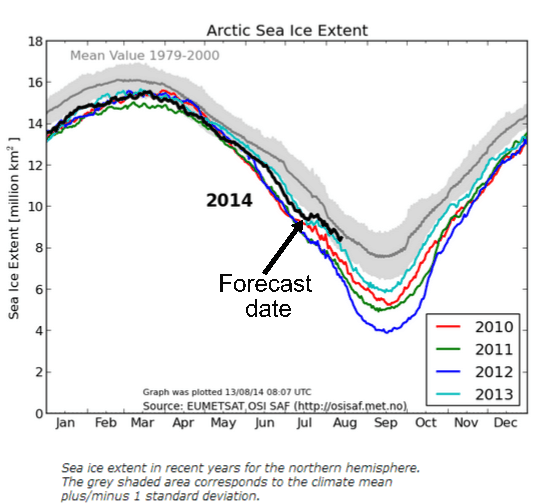During the first week of July, I predicted that Arctic sea ice extent was about to take a sharp turn towards the median. This was based on very simple geometry, geography, current ice conditions and the weather forecast.
Our friends went ballistic, wrote up a story on ClimateCrocks, and sent an army of idiots over here. Five weeks later some of them are still hanging out here claiming that I was wrong. Apparently you just can’t fix stupid.
COI | Centre for Ocean and Ice | Danmarks Meteorologiske Institut



Drudge draws them in. The tenacious ones hang around for awhile before they fade away. never having achieved their goal. Which is to convert rational people to their irrational religion.
Well said philly -er- phil … (sorry, reading a few of the little fish’s post had a bad influence on me)
Say 3 Hail Marys and 2 Our Fathers. Your sin is forgiven. 😉
Ain’t that the truth.
Actually it looks like it might cross the verboten line this time (uptick starting again) as you said some days ago its mostly consolidated now and can only freeze more from now on…
I would be very surprised if it crosses over, because wind conditions are unfavorable
We can always hope.
But I will settle for another ‘polar vortex’ hitting the east coast lefties and freezing their buns off this September. (And watching the MSM try to spin Gore Bull Warbling is causing the cooling.)
A little early to be saying “can only freeze more” … look at the graph and the real freeze is usually timed about Sept 10 – 20th before that some areas are freezing and some melting with overall melt or nothing but ~ mid September the net is more freezing than melting.
Now, apparently, Detroit has NEVER EVER had a flood before:
http://mashable.com/2014/08/12/detroit-flooding-global-warming/
And, of course, it is caused by your SUV.
Funny how Detroit flooded while Windsor Ontario, a few hundred yards away seemd to have the public drainage infrastructure to handle heavy rain.
The storm drain grates in Detroit are likely plugged with empty crack baggies and used condoms.
Isn’t it where all the meth zombies live?
Hell of a job flushing the meth zombies out of the drains, Tom.
Looks like Dallas after receiving one of our usual heavy rains; the problem is the drainage in those _low_ areas is not optimum for heavy rains … but ‘Mashable’ (nor the ignorant WH headed by Valerie Jarrett) wouldn’t know such things … they’re Type “A”, Class “1” idiots …
the problem is none of them believe there is anything but fragile new ice left in the arctic steve ,there is every chance they will have a fit next melt season when there is substantially more 3m plus ice.
i see people looking at satellite images of the arctic and commenting on how much the ice looks like slush,while failing to comprehend they are looking at huge slabs of ice that are metres thick as opposed to thin ice on the brink of melting. they see what they want to see,not what is actually happening.
i think some of them actually want all the ice to melt .
Just curious as to what you think might happen if it did? … Exactly what difference would it make to anything? … You are aware that the Arctic has done that before, right?
What happens if the Arctic Ice all melts?
RACookPE1978 sort of answered that question. (Since the Arctic is a sea it does nothing to the sea level. What it does do is effect the weather.)
‘Since I think he had some things to say that are at least worth thinking about I am going to reproduce them here. (They are a couple of comments on the same subject and since they are technical they are long.)
Gail, are you typing all this on your iPhone ?
No, I am having major problems seeing due to allergies. The old bod, really really hates all the mold in the air.
I do wish an edit function was available in WordUnimpressed.
So their AlGoreithm is not helping their models?
When you mask out the coastal zones it paints a telling picture.
http://ocean.dmi.dk/arctic/old_icecover.uk.php
Which is the way it was always done before….comparing like for like
I will bet those cruise lines booking passage for Northwest Passage Cruises have weasel terms in their contracts to avoid refunds in the case of “inclement ice”.
Otherwise, they’ll be quietly cancelling those cruises.
http://www.seatrade-insider.com/news/news-headlines/crystals-first-expedition-style-voyage-charts-northwest-passage-in-2016.html?nspPage=6
“A 20% initial deposit will be required to secure all bookings, with $500 of the deposit non-refundable.”
It looks like they will be making $500 on each passenger without having to spend a penny on the cruise.
It’s the Acts of Gore clause.
Isn’t it amazing what a rational and non agenda driven human can forecast?